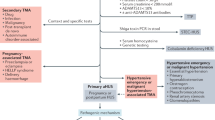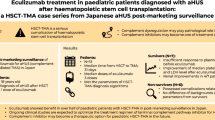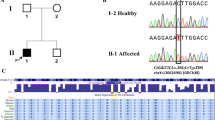Abstract
Haemolytic uraemic syndrome (HUS) is characterized by nonimmune haemolytic anaemia, thrombocytopenia and renal impairment—most incidents in childhood are caused by shiga toxin-producing bacteria. Atypical HUS (aHUS) accounts for 10% of cases and has a poor prognosis. About 60% of patients with aHUS have dysregulation of the alternative complement pathway (complement-mediated aHUS). The kidney is the main target organ, but other organs might also be affected. Cardiac complications occur in 3–10% of patients with complement-mediated aHUS, as a consequence of microangiopathic injury in the coronary microvasculature, and can cause sudden death. Emerging evidence also suggests that either thrombosis or stenosis of the medium and large arteries might complicate disease course, and such disorders occur even after renal function is lost. In this Perspectives article we discuss the impact of cardiovascular involvement in complement-mediated aHUS, the role of acute and chronic complement hyperactivation in such events and the implications for treatment.
This is a preview of subscription content, access via your institution
Access options
Subscribe to this journal
Receive 12 print issues and online access
$209.00 per year
only $17.42 per issue
Buy this article
- Purchase on Springer Link
- Instant access to full article PDF
Prices may be subject to local taxes which are calculated during checkout


Similar content being viewed by others
References
Noris, M. & Remuzzi, G. Atypical hemolytic-uremic syndrome. N. Engl. J. Med. 361, 1676–1687 (2009).
Remuzzi, G., Ruggenenti, P. & Bertani, T. in Renal Pathology: Vol. 2: with Clinical and Functional Correlations (eds Tisher, C. G. & Brenner, B. M.) 1154–1184 (J. B. Lippincott Company, 1994).
Loirat, C., Noris, M. & Fremeaux-Bacchi, V. Complement and the atypical hemolytic uremic syndrome in children. Pediatr. Nephrol. 23, 1957–1972 (2008).
Noris, M. et al. Relative role of genetic complement abnormalities in sporadic and familial aHUS and their impact on clinical phenotype. Clin. J. Am. Soc. Nephrol. 5, 1844–1859 (2010).
Galbusera, M., Noris, M. & Remuzzi, G. Thrombotic thrombocytopenic purpura—then and now. Semin. Thromb. Hemost. 32, 81–89 (2006).
Levy, G. G. et al. Mutations in a member of the ADAMTS gene family cause thrombotic thrombocytopenic purpura. Nature 413, 488–494 (2001).
Furlan, M., Robles, R. & Lamie, B. Partial purification and characterization of a protease from human plasma cleaving von Willebrand factor to fragments produced by in vivo proteolysis. Blood 87, 4223–4234 (1996).
Wahla, A. S. et al. Myocardial infarction in thrombotic thrombocytopenic purpura: a single-center experience and literature review. Eur. J. Haematol. 81, 311–316 (2008).
Sane, D. C., Streer, N. P. & Owen, J. Myocardial necrosis in patients with thrombotic thrombocytopenic purpura: pathophysiology and rationale for specific therapy. Eur. J. Haematol. 82, 83–92 (2009).
Sallee, M. et al. Myocardial infarction is a complication of factor H-associated atypical HUS. Nephrol. Dial. Transplant. 25, 2028–2032 (2010).
Venables, J. P. et al. Atypical haemolytic uraemic syndrome associated with a hybrid complement gene. PLoS Med. 3, e431 (2006).
Vilalta, R. et al. Long-term eculizumab improves clinical outcomes in atypical hemolytic uremic syndrome. Pediatr. Nephrol. 27, 2323–2326 (2012).
Malina, M. et al. Peripheral gangrene in children with atypical hemolytic uremic syndrome. Pediatrics 131, e331–e335 (2013).
Davin, J. C. et al. Maintenance of kidney function following treatment with eculizumab and discontinuation of plasma exchange after a third kidney transplant for atypical hemolytic uremic syndrome associated with a CFH mutation. Am. J. Kidney Dis. 55, 708–711 (2010).
Loirat, C. et al. Non-atheromatous arterial stenoses in atypical haemolytic uraemic syndrome associated with complement dysregulation. Nephrol. Dial. Transplant. 25, 3421–3425 (2010).
Neuhaus, T. J., Calonder, S. & Leumann, E. P. Heterogeneity of atypical haemolytic uraemic syndromes. Arch. Dis. Child. 76, 518–521 (1997).
Dragon-Durey, M. A. et al. Clinical features of anti-factor H autoantibody-associated hemolytic uremic syndrome. J. Am. Soc. Nephrol. 21, 2180–2187 (2010).
Walport, M. J. Complement. First of two parts. N. Engl. J. Med. 344, 1058–1066 (2001).
Ricklin, D., Hajishengallis, G., Yang, K. & Lambris, J. D. Complement: a key system for immune surveillance and homeostasis. Nat. Immunol. 11, 785–797 (2010).
Lachmann, P. J. The amplification loop of the complement pathways. Adv. Immunol. 104, 115–149 (2009).
Woodruff, T. M., Nandakumar, K. S. & Tedesco, F. Inhibiting the C5-C5a receptor axis. Mol. Immunol. 48, 1631–1642 (2011).
Podack, E. R., Kolb, W. P. & Muller-Eberhard, H. J. The SC5b-7 complex: formation, isolation, properties, and subunit composition. J. Immunol. 119, 2024–2029 (1977).
Zipfel, P. F. & Skerka, C. Complement regulators and inhibitory proteins. Nat. Rev. Immunol. 9, 729–740 (2009).
Saunders, R. E. et al. The interactive factor H-atypical hemolytic uremic syndrome mutation database and website: update and integration of membrane cofactor protein and factor I mutations with structural models. Hum. Mutat. 28, 222–234 (2007).
FH aHUS Mutation Database [online], (2007).
Richards, A. et al. Factor H mutations in hemolytic uremic syndrome cluster in exons 18–20, a domain important for host cell recognition. Am. J. Hum. Genet. 68, 485–490 (2001).
Caprioli, J. et al. Genetics of HUS: the impact of MCP, CFH, and IF mutations on clinical presentation, response to treatment, and outcome. Blood 108, 1267–1279 (2006).
Warwicker, P. et al. Genetic studies into inherited and sporadic hemolytic uremic syndrome. Kidney Int. 53, 836–844 (1998).
Manuelian, T. et al. Mutations in factor H reduce binding affinity to C3b and heparin and surface attachment to endothelial cells in hemolytic uremic syndrome. J. Clin. Invest. 111, 1181–1190 (2003).
Francis, N. J. et al. A novel hybrid CFH/CFHR3 gene generated by a microhomology-mediated deletion in familial atypical hemolytic uremic syndrome. Blood 119, 591–601 (2012).
Eyler, S. J. et al. A novel hybrid CFHR1/CFH gene causes atypical hemolytic uremic syndrome. Pediatr. Nephrol. 28, 2221–2225 (2013).
Dragon-Durey, M. A. et al. Anti-factor H autoantibodies associated with atypical hemolytic uremic syndrome. J. Am. Soc. Nephrol 16, 555–563 (2005).
Hofer, J. et al. Complement factor H-related protein 1 deficiency and factor H antibodies in pediatric patients with atypical hemolytic uremic syndrome. Clin. J. Am. Soc. Nephrol. 8, 407–415 (2013).
Sinha, A. et al. Prompt plasma exchanges and immunosuppressive treatment improves the outcomes of anti-factor H autoantibody-associated hemolytic uremic syndrome in children. Kidney Int. http://dx.doi.org/10.1038/ki.2013.373
Jozsi, M. et al. Anti factor H autoantibodies block C-terminal recognition function of factor H in hemolytic uremic syndrome. Blood 110, 1516–1518 (2007).
Jozsi, M. et al. Factor H autoantibodies in atypical hemolytic uremic syndrome correlate with CFHR1/CFHR3 deficiency. Blood 111, 1512–1514 (2008).
Richards, A. et al. Mutations in human complement regulator, membrane cofactor protein (CD46), predispose to development of familial hemolytic uremic syndrome. Proc. Natl Acad. Sci. USA 100, 12966–12971 (2003).
Noris, M. et al. Familial haemolytic uraemic syndrome and an MCP mutation. Lancet 362, 1542–1547 (2003).
Kavanagh, D. et al. Characterization of mutations in complement factor I (CFI) associated with hemolytic uremic syndrome. Mol. Immunol. 45, 95–105 (2008).
Goicoechea de Jorge, E. et al. Gain-of-function mutations in complement factor B are associated with atypical hemolytic uremic syndrome. Proc. Natl Acad. Sci. USA 104, 240–245 (2007).
Fremeaux-Bacchi, V. et al. Mutations in complement C3 predispose to development of atypical hemolytic uremic syndrome. Blood 112, 4948–4952 (2008).
Delvaeye, M. et al. Mutations in thrombomodulin in hemolytic-uremic syndrome. N. Engl. J. Med. 361, 345–357 (2009).
Maga, T. K., Nishimura, C. J., Weaver, A. E., Frees, K. L. & Smith, R. J. Mutations in alternative pathway complement proteins in American patients with atypical hemolytic uremic syndrome. Hum. Mutat. 31, E1445–E1460 (2010).
Shulga, Y. V., Topham, M. K. & Epand, R. M. Regulation and functions of diacylglycerol kinases. Chem. Rev. 111, 6186–6208 (2011).
Lemaire, M. et al. Recessive mutations in DGKE cause atypical hemolytic-uremic syndrome. Nat. Genet. 45, 531–536 (2013).
Bresin, E. et al. Combined complement gene mutations in atypical hemolytic uremic syndrome influence clinical phenotype. J. Am. Soc. Nephrol. 24, 475–486 (2013).
Schmidtko, J., Peine, S., El-Housseini, Y., Pascual, M. & Meier, P. Treatment of atypical hemolytic uremic syndrome and thrombotic microangiopathies: a focus on eculizumab. Am. J. Kidney Dis. 61, 289–299 (2013).
Legendre, C. M. et al. Terminal complement inhibitor eculizumab in atypical hemolytic-uremic syndrome. N. Engl. J. Med. 368, 2169–2181 (2013).
Rathbone, J. et al. A systematic review of eculizumab for atypical haemolytic uraemic syndrome (aHUS). BMJ Open 3, e003573 (2013).
Sellier-Leclerc, A. L. et al. Differential impact of complement mutations on clinical characteristics in atypical hemolytic uremic syndrome. J. Am. Soc. Nephrol. 18, 2392–2400 (2007).
Patschan, D. et al. Acute myocardial infarction in thrombotic microangiopathies--clinical characteristics, risk factors and outcome. Nephrol. Dial. Transplant. 21, 1549–1554 (2006).
Abarrategui-Garrido, C., Martinez-Barricarte, R., Lopez-Trascasa, M., de Cordoba, S. R. & Sanchez-Corral, P. Characterization of complement factor H-related (CFHR) proteins in plasma reveals novel genetic variations of CFHR1 associated with atypical hemolytic uremic syndrome. Blood 114, 4261–4271 (2009).
Roumenina, L. T. et al. A prevalent C3 mutation in aHUS patients causes a direct C3 convertase gain of function. Blood 119, 4182–4191 (2012).
Le Quintrec, M. et al. Complement genes strongly predict recurrence and graft outcome in adult renal transplant recipients with atypical hemolytic and uremic syndrome. Am. J. Transplant. 13, 663–675 (2013).
Ozel, A., Caliskan, U. & Gucer, S. Peripheral gangrene complicating hemolytic uremic syndrome in a child. Pediatr. Nephrol. 18, 465–467 (2003).
Kaplan, B. S. et al. Peripheral gangrene complicating idiopathic and recessive hemolytic uremic syndromes. Pediatr. Nephrol. 14, 985–989 (2000).
Singh, S., de Trafford, J. C., Goss, D. E., Baskerville, P. A. & Roberts, V. C. Ultrasound imaging of digital arteries. Clin. Phys. Physiol. Meas. 11, 313–317 (1990).
Hill, G. S., Heudes, D. & Bariety, J. Morphometric study of arterioles and glomeruli in the aging kidney suggests focal loss of autoregulation. Kidney Int. 63, 1027–1036 (2003).
Remuzzi, G. et al. Bilateral nephrectomy stopped disease progression in plasma-resistant hemolytic uremic syndrome with neurological signs and coma. Kidney Int. 49, 282–286 (1996).
Vergouwen, M. D., Adriani, K. S., Roos, Y. B., Groothoff, J. W. & Majoie, C. B. Proximal cerebral artery stenosis in a patient with hemolytic uremic syndrome. AJNR 29, e34 (2008).
Bekassy, Z. D. et al. Eculizumab in an anephric patient with atypical haemolytic uraemic syndrome and advanced vascular lesions. Nephrol. Dial. Transplant. 28, 2899–2907 (2013).
Weber, C. & Noels, H. Atherosclerosis: current pathogenesis and therapeutic options. Nat. Med. 17, 1410–1422 (2011).
Sawada, M. et al. Prevention of neointimal formation by a serine protease inhibitor, FUT-175, after carotid balloon injury in rats. Stroke 30, 644–650 (1999).
Tanaskovic, S., Isenovic, E. R. & Radak, D. Inflammation as a marker for the prediction of internal carotid artery restenosis following eversion endarterectomy—evidence from clinical studies. Angiology 62, 535–542 (2011).
Noris, M., Mescia, F. & Remuzzi, G. STEC-HUS, atypical HUS and TTP are all diseases of complement activation. Nat. Rev. Nephrol. 8, 622–633 (2012).
Klos, A. et al. The role of the anaphylatoxins in health and disease. Mol. Immunol. 46, 2753–2766 (2009).
Yanamoto, H., Kataoka, H., Nakajo, Y. & Iihara, K. The role of the host defense system in the development of cerebral vasospasm: analogies between atherosclerosis and subarachnoid hemorrhage. Eur. Neurol. 68, 329–343 (2012).
Haskard, D. O., Boyle, J. J. & Mason, J. C. The role of complement in atherosclerosis. Curr. Opin. Lipidol. 19, 478–482 (2008).
Lilien, M. R. & Groothoff, J. W. Cardiovascular disease in children with CKD or ESRD. Nat. Rev. Nephrol. 5, 229–235 (2009).
Nilsson, B., Ekdahl, K. N., Mollnes, T. E. & Lambris, J. D. The role of complement in biomaterial-induced inflammation. Mol. Immunol. 44, 82–94 (2007).
Ažukaitis, K., Loirat, C., Malina, M., Adomaitiene, I. & Jankauskiene, A. Macrovascular involvement in a child with atypical hemolytic uremic syndrome. Pediatr. Nephrol. http://dx.doi.org/10.1007/s00467-013-2713-3.
Acknowledgements
The authors are partially supported by grants from Fondazione ART per la Ricerca sui Trapianti ONLUS, (Milan, Italy) and the European Community (FP7 Grant 2012-305,608 EURenOmics).
Author information
Authors and Affiliations
Contributions
M. Noris researched the data and wrote the article. G. Remuzzi reviewed and edited the manuscript before submission. Both authors made substantial contribution to discussion of the article content.
Corresponding author
Ethics declarations
Competing interests
The authors declare no competing financial interests.
Rights and permissions
About this article
Cite this article
Noris, M., Remuzzi, G. Cardiovascular complications in atypical haemolytic uraemic syndrome. Nat Rev Nephrol 10, 174–180 (2014). https://doi.org/10.1038/nrneph.2013.280
Published:
Issue Date:
DOI: https://doi.org/10.1038/nrneph.2013.280
This article is cited by
-
Autonomic activity and cardiovascular system risk assessment in pediatric patients with hemolytic uremic syndrome
European Journal of Pediatrics (2024)
-
Atypical haemolytic uremic syndrome with refractory multiorgan involvement and heterozygous CFHR1/CFHR3 gene deletion
BMC Nephrology (2023)
-
Atypical hemolytic uremic syndrome in the Colombian Caribbean: its particular characteristics
International Urology and Nephrology (2022)
-
Occlusive retinal vasculopathy with macular branch retinal artery occlusion as a leading sign of atypical hemolytic uremic syndrome – a case report
BMC Ophthalmology (2021)
-
Pericardial effusion in anti-complement factor H antibody-associated atypical hemolytic uremic syndrome: two case reports
CEN Case Reports (2021)



